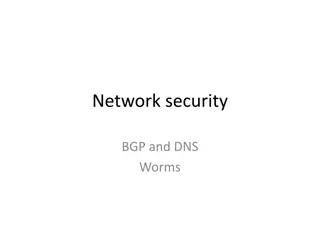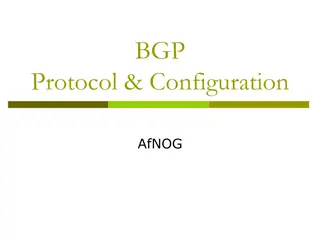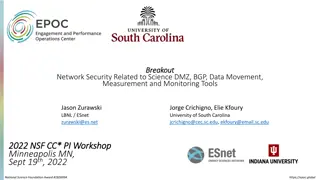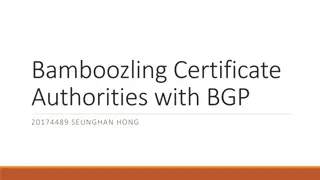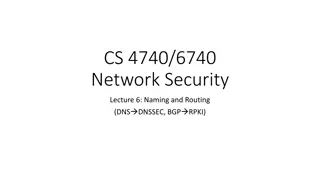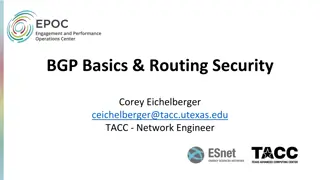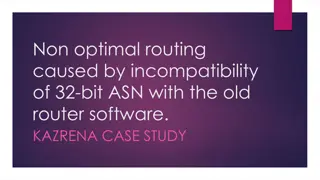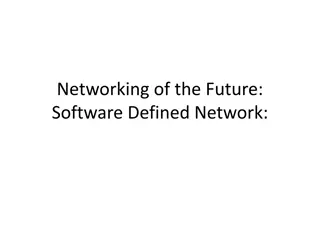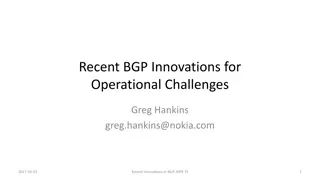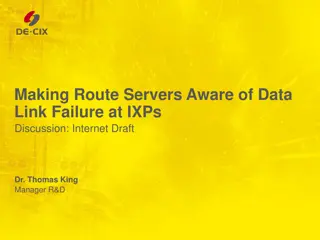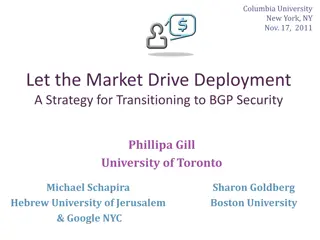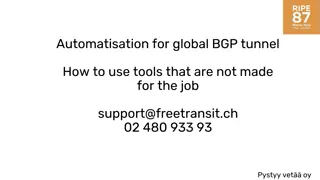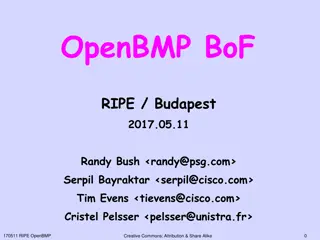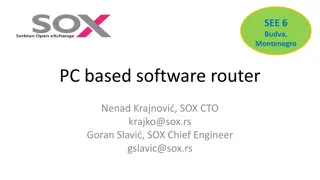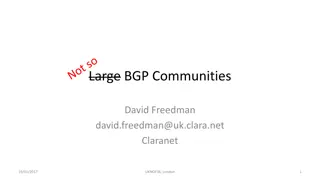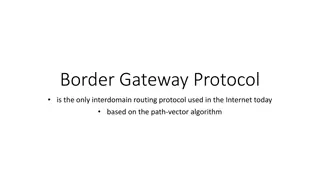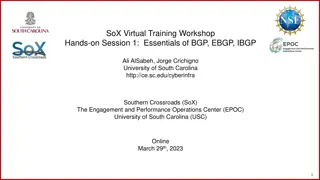
Understanding BGP Protocol Basics
Explore the basics of BGP protocol including terminology, peering, routing policies, and network design. Learn about the operation of BGP, its role in ASes, and the key aspects of path selection and policy enforcement. Dive into case studies and exercises to deepen your knowledge in Border Gateway Protocol.
Download Presentation

Please find below an Image/Link to download the presentation.
The content on the website is provided AS IS for your information and personal use only. It may not be sold, licensed, or shared on other websites without obtaining consent from the author. If you encounter any issues during the download, it is possible that the publisher has removed the file from their server.
You are allowed to download the files provided on this website for personal or commercial use, subject to the condition that they are used lawfully. All files are the property of their respective owners.
The content on the website is provided AS IS for your information and personal use only. It may not be sold, licensed, or shared on other websites without obtaining consent from the author.
E N D
Presentation Transcript
BGP Protocol & Configuration AfNOG
Border Gateway Protocol (BGP4) p Case Study 1, Exercise 1: Single upstream p Part 6: BGP Protocol Basics p Part 7: BGP Protocol - more detail p Case Study 2, Exercise 2: Local peer p Part 8: Routing Policy and Filtering p Exercise 3: Filtering on AS-path p Exercise 4: Filtering on prefix-list p Part 9: More detail than you want p Exercise 5: Interior BGP p Part 10: BGP and Network Design
BGP Part 6 BGP Protocol Basics Terminology General Operation Interior/Exterior BGP
BGP Protocol Basics Peering A C AS 100 AS 101 B D p Routing Protocol used between ASes If you aren t connected to multiple ASes you don t need BGP p Runs over TCP E AS 102
BGP Protocol Basics p Uses Incremental updates sends one copy of the RIB at the beginning, then sends changes as they happen p Path Vector protocol keeps track of the AS path of routing information p Many options for policy enforcement
Terminology p Neighbour Configured BGP peer p NLRI/Prefix NLRI network layer reachability information Reachability information for an IP address & mask p Router-ID 32 bit integer to uniquely identify router Comes from Loopback or Highest IP address configured on the router p Route/Path NLRI advertised by a neighbour
Terminology p Transit carrying network traffic across a network, usually for a fee p Peering exchanging routing information and traffic your customers and your peers customers network information only. not your peers peers; not your peers providers. p Peering also has another meaning: BGP neighbour, whether or not transit is provided p Default where to send traffic when there is no explicit route in the routing table
BGP Basics p Each AS originates a set of NLRI (routing announcements) p NLRI is exchanged between BGP peers p Can have multiple paths for a given prefix p BGP picks the best path and installs in the IP forwarding table p Policies applied (through attributes) influences BGP path selection
Interior BGP vs. Exterior BGP p Interior BGP (iBGP) Between routers in the same AS Often between routers that are far apart Should be a full mesh: every iBGP router talks to all other iBGP routers in the same AS p Exterior BGP (eBGP) Between routers in different ASes Almost always between directly-connected routers (ethernet, serial line, etc.)
BGP Peers A C AS 101 100.100.16.0/24 AS 100 100.100.8.0/24 B D BGP Peers exchange Update messages containing Network Layer Reachability Information (NLRI) E AS 102 100.100.32.0/24 BGP Update Messages
BGP Peers External (eBGP) A C AS 101 100.100.16.0/24 AS 100 100.100.8.0/24 B D BGP speakers are called peers E Peers in different AS s are called External Peers AS 102 100.100.32.0/24 eBGP TCP/IP Peer Connection Note: eBGP Peers normally should be directly connected.
BGP Peers Internal (iBGP) A C AS 101 100.100.16.0/24 AS 100 100.100.8.0/24 B D BGP speakers are called peers E Peers in the same AS are called Internal Peers AS 102 100.100.32.0/24 iBGP TCP/IP Peer Connection Note: iBGP Peers don t have to be directly connected.
Configuring eBGP peers p BGP peering sessions are established using the BGP neighbor command eBGP is configured when AS numbers are different AS 101 AS 100 110.110.10.0/30 A C D B 100.100.8.0/30 100.100.16.0/30 .2 .1 .2 .1 .2 .1 interface Serial 0 ip address 110.110.10.2 255.255.255.252 router bgp 100 network 100.100.8.0 mask 255.255.255.0 neighbor 110.110.10.1 remote-as 101 interface Serial 0 ip address 110.110.10.1 255.255.255.252 router bgp 101 network 100.100.16.0 mask 255.255.255.0 neighbor 110.110.10.2 remote-as 100
Configuring iBGP peers p BGP peering sessions are established using the BGP neighbor command iBGP is configured when AS numbers are the same AS 101 AS 100 110.110.10.0/30 A C D B 100.100.8.0/30 100.100.16.0/30 .2 .1 .2 .1 .2 .1 interface Serial 1 ip address 100.100.16.1 255.255.255.252 interface Serial 1 ip address 100.100.16.2 255.255.255.252 router bgp 101 network 100.100.16.0 mask 255.255.255.0 neighbor 100.100.16.1 remote-as 101 router bgp 101 network 100.100.16.0 mask 255.255.255.0 neighbor 100.100.16.2 remote-as 101
Configuring iBGP peers: Full mesh p Each iBGP speaker must peer with every other iBGP speaker in the AS AS 100 A B iBGP TCP/IP Peer Connection C
Configuring iBGP peers: Full mesh p Each iBGP speaker must peer with every other iBGP speaker in the AS p This can be a pain if there are many routers, but there are ways to deal with it (route reflectors) B A C iBGP TCP/IP Peer Connection E D
Configuring iBGP peers: Loopback interface p Loopback interfaces are normally used as the iBGP peer connection end-points AS 100 105.10.7.1 105.10.7.2 A B 105.10.7.3 iBGP TCP/IP Peer Connection C
Configuring iBGP peers AS 100 105.10.7.2 105.10.7.1 A B 105.10.7.3 interface loopback 0 ip address 105.10.7.1 255.255.255.255 C router bgp 100 network 105.10.7.0 mask 255.255.255.0 neighbor 105.10.7.2 remote-as 100 neighbor 105.10.7.2 update-source loopback0 neighbor 105.10.7.3 remote-as 100 neighbor 105.10.7.3 update-source loopback0
Configuring iBGP peers AS 100 105.10.7.2 105.10.7.1 A B 105.10.7.3 iBGP TCP/IP Peer Connection interface loopback 0 ip address 105.10.7.2 255.255.255.255 C router bgp 100 network 105.10.7.0 mask 255.255.255.0 neighbor 105.10.7.1 remote-as 100 neighbor 105.10.7.1 update-source loopback0 neighbor 105.10.7.3 remote-as 100 neighbor 105.10.7.3 update-source loopback0
Configuring iBGP peers AS 100 105.10.7.2 105.10.7.1 A B 105.10.7.3 interface loopback 0 ip address 105.10.7.3 255.255.255.255 C router bgp 100 network 105.10.7.0 mask 255.255.255.0 neighbor 105.10.7.1 remote-as 100 neighbor 105.10.7.1 update-source loopback0 neighbor 105.10.7.2 remote-as 100 neighbor 105.10.7.2 update-source loopback0

